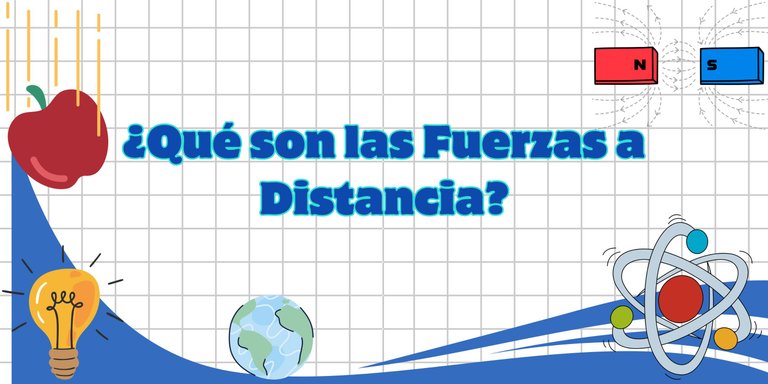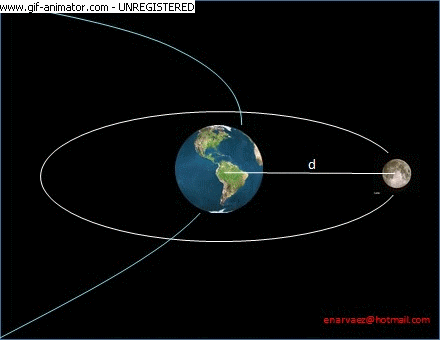¿Qué son las Fuerzas a Distancia? // What are Distant Forces?
Hello dear hive community! 😉
¡Hola querida comunidad de hive! 😉
En esta ocasión me gustaría hacerle una pregunta, ¿Por qué caen los objetos? ¿Por qué se atraen los imanes? Cosas así trataremos de entender hoy en un tema muy importante para la física como son las fuerzas a distancia.
On this occasion I would like to ask you a question: Why do objects fall? Why do magnets attract each other? Things like this we will try to understand today in a very important topic for physics such as forces at a distance.

Imagen realizada con la página web de diseño gráfico y composición de imágenes Canva // Image made with the graphic design and image composition website Canva.
Antes de comenzar sería bueno primero entender un poco el concepto de fuerza, la cual se le conoce como una magnitud física vectorial que representa la interacción entre dos cuerpos, dicha magnitud es capaz de cambiar el movimiento de los cuerpos o deformarlos. Es un principio que rige los fenómenos de nuestra vida y cabe resaltar que se mide en una unidad física llamada “Newton” que es la relación entre la masa y la aceleración, es decir, kg.m/s2.
Él término fuerza es muy utilizado en nuestra cotidianidad a pesar de no establecerlo tal como la física lo define, sin embargo es importante acotar que a nivel cuántico se habla de cuatro fuerzas fundamentales como lo son la fuerza gravitacional, la fuerza electromagnética, la fuerza nuclear fuerte y la fuerza nuclear débil. Mientras que en la mecánica newtoniana o clásica las fuerzas son la fuerza de roce, la fuerza centrípeta, la fuerza gravitatoria, entre otras.
Before starting it would be good to first understand a little the concept of force, which is known as a vector physical quantity that represents the interaction between two bodies, this quantity is able to change the movement of bodies or deform them. It is a principle that governs the phenomena of our life and it should be noted that it is measured in a physical unit called “Newton” which is the ratio between mass and acceleration, i.e. kg.m/s2.
The term force is widely used in our daily life despite not establishing it as physics defines it, however it is important to note that at the quantum level we speak of four fundamental forces such as the gravitational force, the electromagnetic force, the strong nuclear force and the weak nuclear force. While in Newtonian or classical mechanics the forces are the frictional force, the centripetal force, the gravitational force, among others.

Source
Ahora bien, la fuerza puede presentar ciertas características como ser una magnitud física que describe la intensidad de las interacciones entre los objetos, se encuentra directamente relacionada con la energía, se encuentra compuesta por una magnitud y una dirección según la mecánica clásica, se representa mediante un vector.
No obstante, ya nombramos fuerzas a distancia y fuerzas de contacto, Pero nuestro interés de hoy son las fuerzas a distancia o también conocidas como fuerzas de acción a distancia, son aquellas que no necesitan que los objetos que interactúan se encuentren en contacto físico.
Entre las fuerzas a distancia tenemos la gravitacional, electrostática, magnética y las nucleares. Entre las más populares se encuentran la gravedad, esta surge de cuerpos con masa y tiene una característica fundamental, siempre es de atracción. Se le conoce como peso, cuando la tierra ejerce la fuerza y el que la recibe se encuentra cerca de ella, Pero es importante acotar que existen cualesquiera objetos con masa, aunque si la masa es extremadamente pequeña la fuerza de atracción entre ellos puede que no sea evidente. También hay que recalcar, que es de largo alcance, por eso ella se manifiesta poderosamente a escala cósmica, es quien mantiene a los planetas y otros objetos del sistema solar en sus respectivas órbitas.
Now, force can present certain characteristics such as being a physical quantity that describes the intensity of interactions between objects, it is directly related to energy, it is composed of a magnitude and a direction according to classical mechanics, it is represented by a vector.
However, we have already mentioned forces at a distance and contact forces, but today we are interested in forces at a distance or also known as action forces at a distance, which are those that do not require the interacting objects to be in physical contact.
Among the forces at a distance we have gravitational, electrostatic, magnetic and nuclear forces. Among the most popular are gravity, this arises from bodies with mass and has a fundamental characteristic, it is always of attraction. It is known as weight, when the earth exerts the force and the one who receives it is close to it, but it is important to note that there are any objects with mass, although if the mass is extremely small the force of attraction between them may not be evident. It is also necessary to emphasize, that it is of long reach, for that reason she is manifested powerfully to cosmic scale, it is who maintains the planets and other objects of the solar system in their respective orbits.

Source
Por otra parte, tenemos las fuerza electrostática, ella actúa en los objetos con carga eléctrica y la misma puede ser de atracción o repulsión. Existen dos tipos de cargas positivas y negativas; en el átomo encontramos los protones con carga positiva en el núcleo del mismo, electrones con carga negativa alrededor de él. Él átomo por lo general es neutro, pero en ocasiones la materia se ioniza, es decir, adquiere o pierde exceso de electrones y en ese caso existe una carga neta la cual puede interactuar con otras cargas.
On the other hand, we have the electrostatic force, it acts on objects with electric charge and it can be of attraction or repulsion. There are two types of positive and negative charges; in the atom we find positively charged protons in its nucleus and negatively charged electrons around it. The atom is usually neutral, but sometimes matter ionizes, that is, it acquires or loses excess electrons and in that case there is a net charge which can interact with other charges.

Source
La fuerza magnética también es una fuerza a distancia, la magnetita es un óxido capaz de atraer trozos de minerales a base de hierro, este material se utiliza para hacer imanes. Estos desvían la brújula y también un alambre por el que circula una corriente eléctrica actual como un imán, y es que el magnetismo está asociado a las cargas eléctricas en movimiento. Una característica de los imanes es su polaridad, los cuales son el polo norte y el polo sur, los polos opuestos se atraen y los polos iguales se repelen.
Por último, tenemos las fuerzas nucleares, estás fuerzas no son fáciles de observar pero tienen la importante misión de mantener la estabilidad en el núcleo atómico. Son fuerzas de corto alcance, ya que solo actúan a distancias semejantes al tamaño del núcleo atómico, es cuál es aproximadamente del orden de 10 a la menos 15.
Magnetic force is also a force at a distance, magnetite is an oxide capable of attracting pieces of iron-based minerals, this material is used to make magnets. These deflect the compass and also a wire through which circulates an electric current current as a magnet, and is that magnetism is associated with electric charges in motion. A characteristic of magnets is their polarity, which are the north pole and south pole, opposite poles attract and equal poles repel.
Finally, we have the nuclear forces, these forces are not easy to observe but have the important mission of maintaining stability in the atomic nucleus. They are short-range forces, since they only act at distances similar to the size of the atomic nucleus, which is approximately of the order of 10 to minus 15.

Source
Finalmente, es propicio comentar la importancia que tienen las fuerzas a distancia porque en su accionar ellas se complementan para darle forma al universo que hoy en día podemos disfrutar.
Finally, it is appropriate to comment on the importance of the forces at a distance because in their actions they complement each other to shape the universe that we can enjoy today.
Ya para despedirme espero que el tema sea del agrado de los lectores y deseo ver en los comentarios sus opiniones y aportes significativos que ayuden a la ampliación del tema y que genere un debate crítico y enriquecedor para la satisfactoria divulgación del conocimiento científico
In closing, I hope that the topic is to the readers' liking and I hope to see in the comments your opinions and significant contributions that will help to broaden the topic and generate a critical and enriching debate for the satisfactory dissemination of scientific knowledge.
Referencias
GIANCOLI, DOUGLAS. (2007). Física. Editorial: Pearson
Serway, R; Jewett J. (2005). Física para Ciencias e Ingeniería. Editorial Thomson: México.
Zemansky, S. (2009). Física Universitaria Volumen II. México: Pearson Educación.
References
GIANCOLI, DOUGLAS. (2007). Physics. Publisher: Pearson
Serway, R; Jewett J. (2005). Physics for Science and Engineering. Editorial Thomson: México.
Zemansky, S. (2009). Physics Volume II. Mexico: Pearson Educación.
Translator Deepl


Posted Using INLEO
https://x.com/ILovePhysica/status/1933315326411768185?t=P0D_PpsO2aGxBXJvxaWSqw&s=19
Thanks for your contribution to the STEMsocial community. Feel free to join us on discord to get to know the rest of us!
Please consider delegating to the @stemsocial account (85% of the curation rewards are returned).
Consider setting @stemsocial as a beneficiary of this post's rewards if you would like to support the community and contribute to its mission of promoting science and education on Hive.
Gracias por el apoyo @stemsocial
muy buen articulo, bastante didáctico y bien explicado a cerca de las fuerzas y sus ejemplos
Hola @dobro2020
Me alegra que te haya gustado, en realidad es un tema muy interesante
First of all, congratulations for this beautiful post. I believe that it is very important to also create educational content right here within the HIVE platform. I noticed that you published this post within the Stemsocial community. At this point, I wanted to ask you a question. Do you know what the difference is between the StemSocial community and Stem? !DIY
Hello @stefano.massari
I'm glad you like my educational content. I really don't know the stem community
Thanks for the reply anyway. So can you confirm that you post all your educational content in the StemSocial community? !HUG